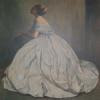

The Enchanting Evil is next in our Barbara Cartland series featuring the artistic covers of Francis Marshall! This book has three different FM illustrations.
The Enchanting Evil is the story of Melinda, who escapes her relations and goes to London in search of work. What she finds is an extraordinary offer to pose as the wife of the Marquis of Chard! Can she escape the evil following her and find love?
The Arrow (UK) cover shows our couple sitting on a sofa. Our heroine is pretty in white trimmed in blue and dressed in the fashions of the mid 1800's. Our hero gazes at her and we also see others sitting at a table, either eating or playing a game. This cover seems more "quickly drawn" than the US version below it. This edition was published in 1970.

The Jove (US) version was published in 1978 and is essentially the same pose and picture in the UK book. I think that it's better drawn, smaller, and more intimate. We see the sweet expression on the heroine's face and the tender look that the hero gives her. There are also others in the background, but they are standing. The green sofa and palm tree are in both covers. Which cover do you like and why?
The third photo comes from an old hardcover jacket version and would be one of the first ones illustrated by Francis Marshall!

I like the US cover best because it looks like a marvelous painting, which is what I love about FM's covers in Bantam. :-)
ReplyDeleteWhat I find interesting about both of these covers is that the dress and the pose appear to have been referenced from Franz Xaver Winterhalter's famous painting, "Eugénie, Empress of the French and her Ladies in Waiting, 1855" : http://commons.wikimedia.org/wiki/Franz_Xaver_Winterhalter#/media/File:Winterhalter_Eugenie_1855.jpg. The dress in question is the blue and white one on the lower left hand side. The pose from the second book come from the Empress Eugenie herself (note the arm lying on the dress in both poses.) Francis Marshall appears to have drawn the second arm as a way to distinguish the pose.
ReplyDelete